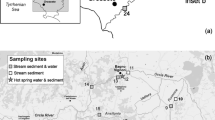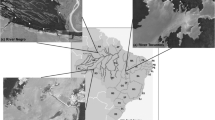Abstract
The purpose of this study was to investigate the effect of sewage treatment on total mercury (THg) and methylmercury (MeHg) concentrations in domestic effluents and the contribution of urban sewage treatment facilities to THg and MeHg in rivers. We determined the concentrations of THg and MeHg in unfiltered samples of untreated and treated domestic sewage from the three treatment facilities and receiving river water within the City of Winnipeg. The concentrations of THg in the Red and Assiniboine rivers ranged from 3–31 ng/L. THg was related positively to suspended sediment concentrations in the rivers. The concentrations of MeHg in these rivers were usually 0.2–0.3 ng/L. THg concentrations in raw sewage varied widely, from 2–150 ng/L. Treatment removed an average of 88% of this mercury. MeHg concentrations in raw sewage were 0.5–4.3 ng/L, however, after treatment at two treatment facilities, MeHg was greatly reduced, usually to 0.1–0.4 ng/L. Most treated sewage, therefore, had MeHg concentrations that were similar to levels in the receiving rivers and the effect of discharged effluent was usually a change of about 2% or less on concentrations in the rivers. However, one of the facilities (the West End plant) was discharging higher concentrations of MeHg, up to 2 ng/L, causing calculated increases of up to 11% in the concentration of MeHg in the Assiniboine River.
Similar content being viewed by others
References
Babiarz CL & Andren AW (1995) Total concentrations of mercury in Wisconsin (USA) lakes and rivers. Water Air Soil Poll. 83: 173–183
Balogh S & Liang L (1995) Mercury pathways in municipal wastewater treatment plants. Water Air Soil Poll. 80: 1181–1190
Balogh SJ, Meyer ML & Johnson KD (1997) Mercury and suspended sediment loadings in the lower Minnesota River. Env. Sci. Technol. 31: 198–202
Bloom NS (1989) Determination of picogram levels of methylmercury by aqueous phase ethylation, followed by cryogenic gas chromatography with cold vapour atomic flourescence detection. Can. J. Fish. Aquat. Sci. 46: 1131–1140
Bloom NS & Crecelius EA (1987) Distribution of silver, mercury, lead, copper and cadmium in central Puget Sound sediments. Mar. Chem. 14: 49–59
Bodaly RA, St. Louis VL, Paterson MJ, Fudge RJP, Hall BD, Rosenberg DM & Rudd JWM (1997) Bioaccumulation of mercury in the aquatic food chain in newly flooded areas, In: Sigel A & Sigel H (Eds) Mercury and its Effects on Environment and Biology (pp 259–287). Marcel Dekker, New York
Driscoll CT, Blette V, Yan C, Schofield CL, Munson R & Holsapple J (1995) The role of dissolved organic carbon in the chemistry and bioavailability of mercury in remote Adirondack lakes. Water Air Soil Poll. 80: 499–508
Gill GA & Bruland KW (1990) Mercury speciation in surface freshwater systems in California and other areas. Environ. Sci. Technol. 24: 1392–1400
Gill GA & Fitzgerald WF (1987) Picomolar mercury measurements in seawater and other materials using stannous chloride reduction and two-stage gold amalgamation with gas phase detection. Mar. Chem. 20: 227–243
Glass GA, Sorensen JA, Schmidt KW & Rapp GR (1990) New source identification of mercury contamination in the Great Lakes. Environ. Sci. Technol. 24: 1059–1069
Horvat M, Liang L & Bloom NS (1993) Comparison of distillation with other current isolation methods for the determination of methyl mercury compounds in low level environmental samples. Part 2: Water. Anal. Chim. Acta 282: 153–168
Hurley JP, Shafer MM, Cowell SE, Overdier JT, Hughes PE & Armstrong DE (1996) Trace metal assessment of Lake Michigan tributaries using low-level techniques. Environ. Sci. Technol. 30: 2093–2098
Mugan TJ (1996) Quantification of total mercury discharges from publicly owned treatment works to Wisconsin surface waters. Water Environ. Res. 68: 229–234
St. Louis VL, Rudd JWM, Kelly CA, Beaty KG, Bloom NS & Flett RJ (1994) Importance of wetlands as sources of methyl mercury to boreal forest ecosystems. Can. J. Fish. Aquat. Sci. 51: 1065–1076
St. Louis VL, Rudd JWM, Kelly CA, Beaty KG, Flett RJ & Roulet NT (1996) Production and loss of methylmercury and loss of total mercury from boreal forest catchments containing different types of wetlands. Environ. Sci. Technol. 30: 2719–2729
Watras CL et al. (1994) Sources and fates of mercury and methylmercury in Wisconsin lakes. In: Watras CJ & Huckabee JW (Eds) Mercury Pollution, Integration and Synthesis (pp 153–177). Lewis Publishers, Boca Raton
Rights and permissions
About this article
Cite this article
Bodaly, R.(., Rudd, W. & Flett, R.J. Effect of urban sewage treatment on total and methyl mercury concentrations in effluents. Biogeochemistry 40, 279–291 (1998). https://doi.org/10.1023/A:1005922202681
Issue Date:
DOI: https://doi.org/10.1023/A:1005922202681




